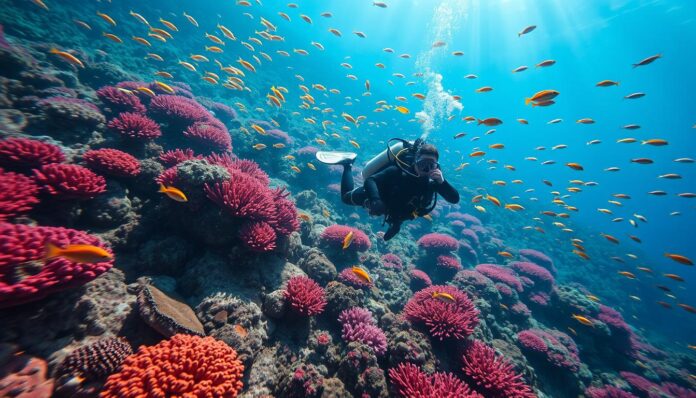Did you know coral reefs cover less than 1% of the ocean but support over 25% of marine life? Scuba diving with Corals Diving offers an amazing underwater adventure. It changes how you see marine ecosystems.
Coral reef exploration is more than just a fun activity. It opens the door to understanding the most complex ecosystems on Earth. Underwater photography lets divers capture the stunning diversity of marine environments. From Cozumel’s National Park’s vibrant coral formations to the detailed marine life, it’s all captured.
Scuba diving with Corals Diving gives you a deep connection with the ocean’s hidden wonders. Our expert guides lead safe, educational, and memorable dives for all skill levels.
Key Takeaways – Diving with Corals
- Discover the incredible biodiversity of coral reef ecosystems
- Learn professional underwater photography techniques
- Experience guided dives with expert marine professionals
- Explore protected marine environments responsibly
- Contribute to marine conservation awareness
What to Expect from a Scuba Diving Adventure
Diving into the underwater world is an extraordinary experience. Scuba diving is more than a sport. It’s a journey that connects you with marine conservation and amazing ecosystems.
Starting a scuba diving adventure means getting ready, feeling excited, and loving to explore. The SSI Open Water Diver certification is a great start for new divers. It helps them explore the marine world safely.
Introduction to Scuba Diving
Your first dive certification is the start of an amazing underwater journey. The program has three key parts:
- Academic Learning: Learning about diving basics
- Confined Water Training: Practicing in safe areas
- Open Water Dives: Using skills in real marine settings
“Scuba diving is about discovering a world few have the privilege to experience.” – Professional Dive Instructor
Understanding Coral Ecosystems
Coral reefs are some of the most diverse ecosystems on Earth. Marine conservation comes alive when you see these underwater worlds up close during snorkeling adventures.
| Coral Reef Significance | Global Impact |
|---|---|
| Home to Marine Species | 25% of all marine life |
| Economic Value | US$ 29.8-375 billion annually |
By joining dive certification programs, you learn important skills. You also become a voice for protecting these delicate marine habitats. Your adventure helps spread the word about coral conservation.
Safety First: Important Precautions
Diving in tropical places needs careful planning and a focus on safety. Knowing key safety steps can make your dive safe and exciting.
Choosing the Right Equipment
Choosing the right scuba gear is key for a safe dive. In 2016, 15% of diving deaths were due to equipment problems. These could have been prevented with simple checks before diving.
- Inspect all gear thoroughly before entering water
- Ensure regulators and masks fit correctly
- Check air tanks for proper pressure
- Verify backup equipment is functional
Understanding Dive Signals
Clear communication underwater is vital in dive resorts and open waters. Learning hand signals can avoid misunderstandings that could be dangerous.
“Plan Your Dive, Dive Your Plan” – A foundational safety guideline for divers
| Signal | Meaning |
|---|---|
| Thumbs Up | End of dive/Return to surface |
| Horizontal Slashing Motion | Problem or Emergency |
| Rotating Finger | Check Air Levels |
Always follow strict safety rules for a fun and safe dive in any water.
The Best Locations for Coral Diving
Start an amazing scuba diving with Corals diving journey around the world’s most stunning underwater spots. Our handpicked dive sites promise unforgettable coral reef exploration. They will spark your love for tropical getaways.
Global Coral Diving Hotspots
For those looking for top marine experiences, there are incredible places to dive. Each spot has its own special features that make diving there a unique adventure.
- Asia:
- Maldives: With its crystal-clear waters and abundant marine life, the Maldives is renowned for its pristine coral reefs. Dive sites such as the North Male Atoll and the Ari Atoll offer stunning coral formations, encounters with mantas and whale sharks, and vibrant underwater landscapes.
- Indonesia: Indonesia boasts some of the world’s most diverse coral reefs. Destinations like Raja Ampat, Komodo National Park, and the Bunaken Marine Park offer breathtaking biodiversity, vibrant coral gardens, and encounters with manta rays, turtles, and various species of sharks.
- Africa:
- Egypt: The Red Sea, with its warm waters and spectacular visibility, offers remarkable diving experiences. The Ras Mohammed National Park, the Straits of Tiran, and the famous SS Thistlegorm wreck are just a few of the highlights where divers can explore colorful coral reefs and encounter a wide variety of marine life.
- Seychelles: The Seychelles archipelago is a paradise for divers, with its picturesque islands and thriving coral reefs. Diving in destinations like Aldabra Atoll, the Amirantes Bank, and the Ste. Anne Marine National Park reveals pristine reefs, impressive granite formations, and encounters with tropical fish, turtles, and reef sharks.
- Caribbean:
- Belize: Belize’s barrier reef, a UNESCO World Heritage Site, offers exceptional diving opportunities. Destinations like the Great Blue Hole, the Turneffe Atoll, and the Hol Chan Marine Reserve showcase incredible coral formations, diverse marine life, and encounters with nurse sharks and rays.
- Bonaire: Known for its easy shore diving, Bonaire offers access to some of the healthiest and most vibrant coral reefs in the Caribbean. The Bonaire Marine Park is home to stunning dive sites teeming with colorful corals, abundant fish life, and the possibility of encountering sea turtles.
- Central America:
- Honduras: The Bay Islands of Honduras, including Roatan, Utila, and Guanaja, are renowned for their remarkable coral reefs. Divers can explore stunning wall dives, encounter colorful reef fish, and have the chance to see larger marine species such as whale sharks and eagle rays.
- Costa Rica: Cocos Island, a UNESCO World Heritage Site, is a remote and pristine diving destination known for its hammerhead shark encounters, massive schools of fish, and impressive coral formations. Diving in Cocos Island offers a thrilling and unforgettable experience.
- Europe:
- Egypt (Red Sea): As mentioned earlier, Egypt’s Red Sea is a prime diving destination, providing access to remarkable coral reefs that are easily accessible from popular resort towns like Hurghada and Sharm El Sheikh.
- Greece: The Greek islands, particularly those in the Ionian and Aegean Seas, offer opportunities to dive among fascinating underwater landscapes, ancient shipwrecks, and beautiful coral formations.
- Oceania:
- Australia: The Great Barrier Reef, the world’s largest coral reef system, is an iconic diving destination. Located off the coast of Queensland, it is a UNESCO World Heritage Site known for its abundant marine life, vibrant corals, and the opportunity to encounter species like turtles, reef sharks, and giant clams.
- Fiji: Fiji’s islands are surrounded by stunning coral reefs that offer diverse dive experiences. From vibrant soft corals to thrilling shark encounters, Fiji’s underwater world provides a feast for the eyes.
- North America:
- Mexico: Mexico’s Riviera Maya, particularly the Yucatan Peninsula, is home to the Mesoamerican Barrier Reef System, the second-largest reef system in the world. Destinations like Cozumel, Playa del Carmen, and Tulum offer a range of dive sites with abundant marine life and beautiful coral formations.
- Florida Keys: The Florida Keys, located off the southern coast of Florida, boast the only living coral barrier reef in the continental United States. Diving in this unique ecosystem allows divers to explore vibrant coral gardens, encounter tropical fish, and even explore historical shipwrecks.
- South America:
- Galapagos Islands, Ecuador: The Galapagos Islands offer a unique diving experience with encounters with marine species found nowhere else on Earth. Divers can swim alongside sea lions, marine iguanas, and schools of hammerhead sharks, while also exploring dramatic volcanic formations.
- Fernando de Noronha, Brazil: This remote archipelago off the coast of Brazil is a UNESCO World Heritage Site and a haven for divers. With its crystal-clear waters and diverse marine life, including dolphins, turtles, and reef sharks, Fernando de Noronha offers a pristine diving experience.
These destinations represent just a fraction of the remarkable coral reef diving opportunities available around the world. Each region offers its own unique marine life, diving conditions, and natural wonders, ensuring that divers of all levels can find their perfect coral reef adventure. Whether you’re a beginner or an experienced diver, these destinations are sure to leave you in awe of the beauty and diversity of coral reef ecosystems.
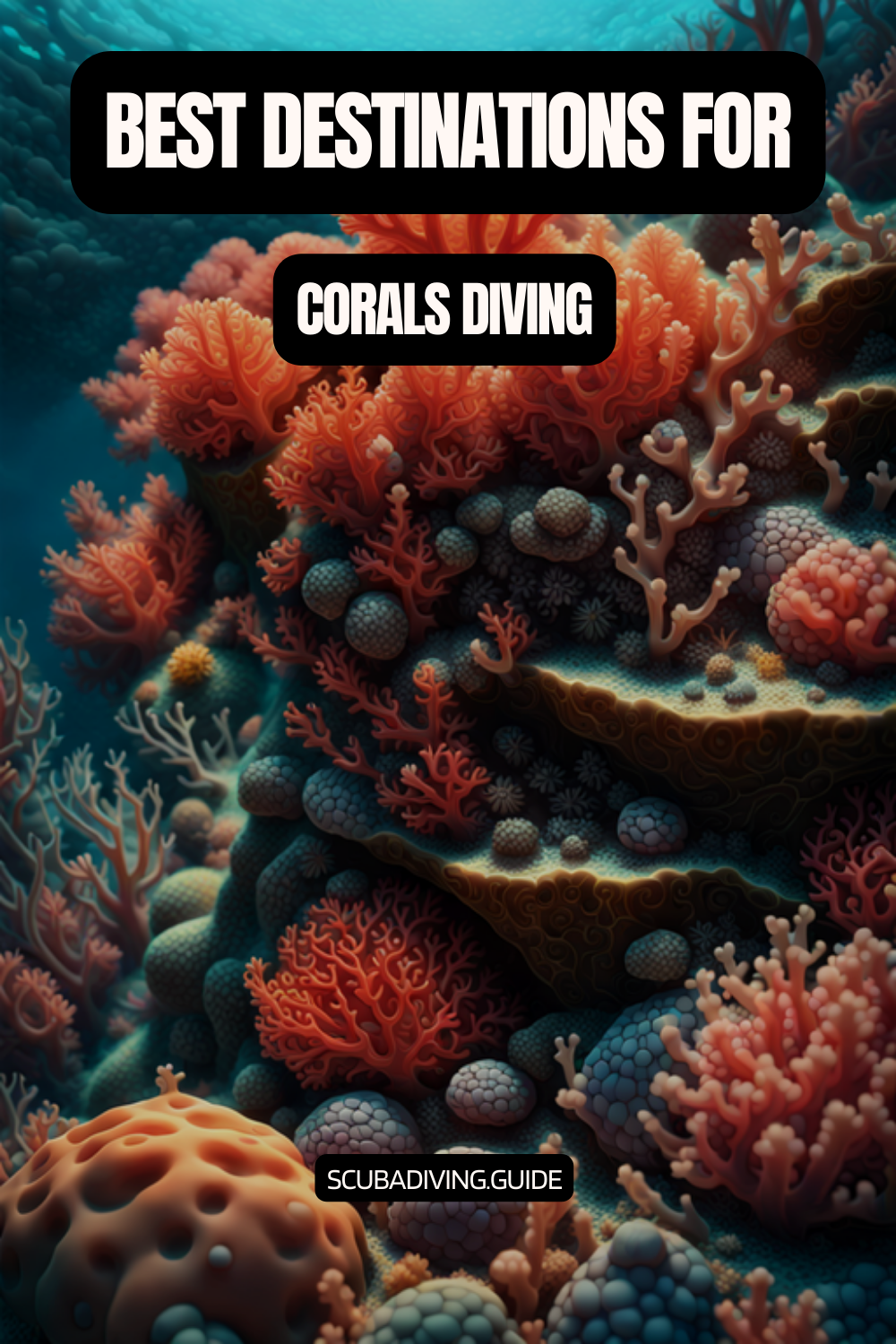
Hidden Gems Worth Discovering
There are also hidden dive sites that are just as amazing but less known. These places offer special experiences for the brave and adventurous.
| Location | Unique Feature | Dive Season |
|---|---|---|
| Lembeh Strait, Indonesia | Rare marine species on black sand | Year-round |
| Malapascua, Philippines | Thresher shark encounters | December-May |
| Wakatobi, Indonesia | World-class house reef | March-December |
“The ocean stirs the heart, inspires the imagination and brings eternal joy to the soul.” – Robert Wyland
Every diving spot is a doorway to the magical world of coral ecosystems. With vibrant marine life and clear waters, these places offer unforgettable experiences for scuba lovers.
Scuba Diving Gear Essentials
Choosing the right scuba gear is key to a great dive. Good equipment keeps you safe and comfortable. It makes your dive unforgettable.
It’s important to pick the right gear for your dive. Whether you’re taking photos underwater or getting certified, knowing what you need is essential.
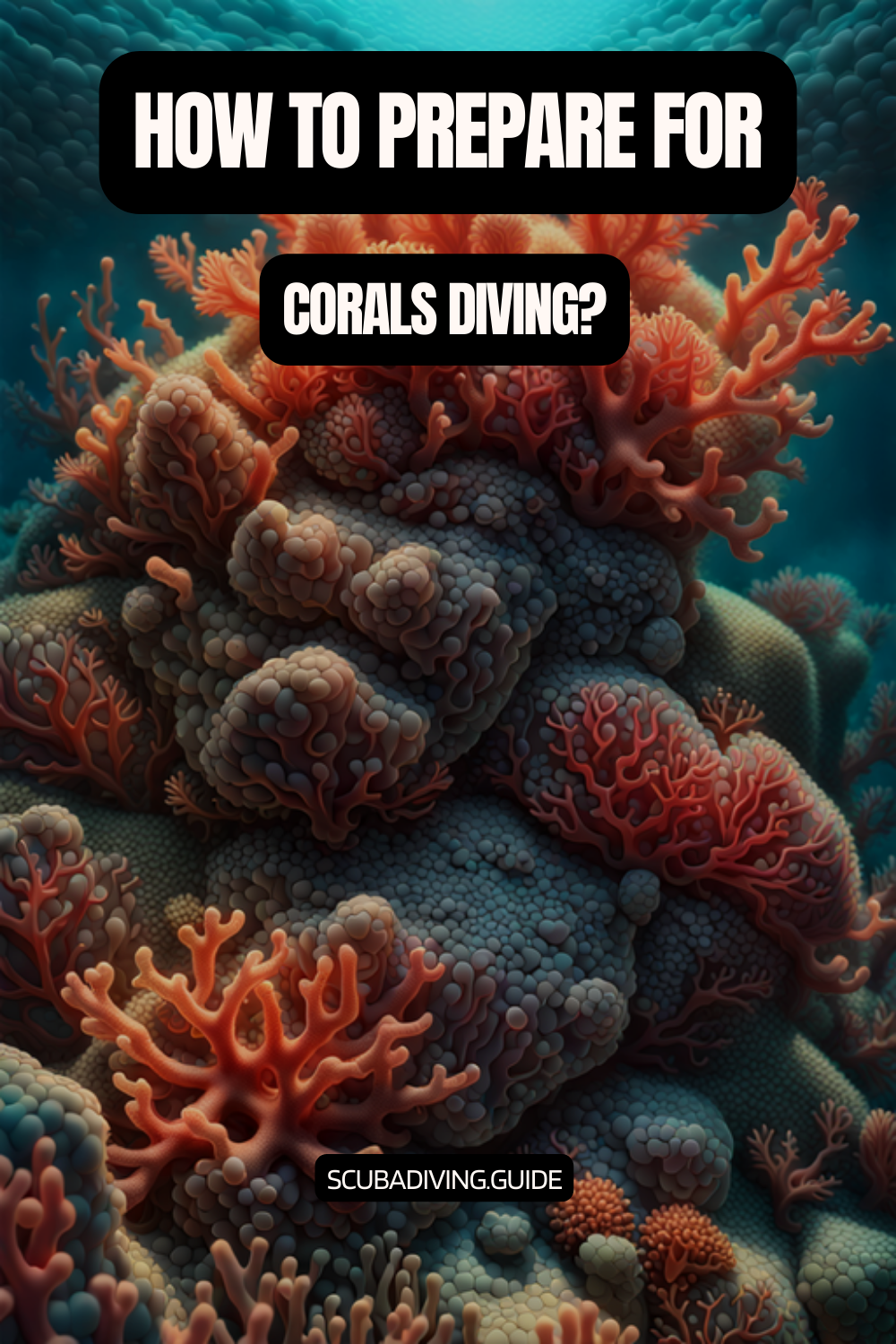
Wetsuits: Keeping Warm Underwater
Water temperature affects how comfortable you are while diving. Here’s a guide to wetsuit thickness:
- 3 mm wetsuit: Ideal for warm waters above 28°C
- 5 mm wetsuit: Perfect for temperatures between 24°C and 28°C
- 7 mm wetsuit: Suitable for temperatures between 18°C and 23°C
- 7 mm semi-drysuit: Recommended for 14°C to 18°C waters
Drysuits vs. Wetsuits: Making the Right Choice
Drysuits are better for cold water because they keep water out. They’re great for diving in water below 14°C. Experienced divers often choose drysuits for extreme conditions.
| Suit Type | Temperature Range | Recommended Use |
|---|---|---|
| Wetsuit | 14°C – 28°C | Recreational diving in moderate temperatures |
| Drysuit | Below 14°C | Cold water and technical diving |
Selecting the Perfect Mask and Fins
When renting scuba gear, focus on fit and comfort. A good mask keeps water out, and the right fins help you move. Think about:
- Mask seal quality
- Fin size and flexibility
- Personal comfort
- Diving environment
“The right gear transforms a good dive into an extraordinary experience.” – Diving Experts
Investing time in choosing the right gear is important. It makes your underwater adventure safer and more enjoyable, whether you’re diving for photos or getting certified.
Planning Your First Dive
Starting your scuba diving journey with Corals Diving opens a new world. It’s perfect for beginners or those wanting to improve their skills. Choosing the right dive school and understanding dive certification are key steps.
Diving certification is your ticket to underwater adventures. It involves several important factors that make your marine experience better:
Selecting the Right Dive School
When picking a dive school for scuba diving with Corals Diving, look at these key points:
- Instructor experience and qualifications
- Safety record and training protocols
- Equipment quality and maintenance
- Student-to-instructor ratio
Understanding Dive Certification Levels
Dive certification has different levels of skill. Here’s a simple guide to entry-level diving qualifications:
| Certification Level | Depth Limit | Minimum Age |
|---|---|---|
| PADI Open Water Diver | 18 meters (59 feet) | 10 years old |
| Advanced Open Water | 30 meters (98 feet) | 15 years old |
*”Your dive certification is more than a card – it’s a key to discovering the hidden wonders of the underwater world.”*
Things to think about for new divers include:
- Basic swimming skills are needed
- Medical check-up for those with health issues
- Expect to burn 300-700 calories per dive
- Wait 18-24 hours before flying after diving
Corals Diving offers full equipment rental. This lets new divers start their journey without a big upfront cost. With skilled instructors and a focus on safety, your first dive will be memorable. It’s a step into the amazing world of marine biology.
Marine Life You May Encounter
Diving into the world of coral reefs opens up a stunning underwater world. It’s full of colorful sea creatures. Underwater photography brings this world to life, showing the amazing variety of sea life.
Colorful Coral Species to Discover
Coral reefs are home to many marine organisms. They are made of calcium carbonate and host a wide range of species. Some of these include:
- Branching corals with tree-like structures
- Brain corals with wrinkled surfaces
- Plate corals spreading across reef surfaces
- Soft corals that move with the ocean currents
Fascinating Fish Variations
Underwater, divers can see many marine species. Some of the most interesting fish include:
| Species | Unique Characteristics | Typical Location |
|---|---|---|
| Clownfish | Vibrant orange with white stripes | Indo-Pacific Reefs |
| Seahorses | Tiny creatures ranging 1.4-30 cm | Indonesia, Honduras |
| Pufferfish | Unique defensive inflation mechanism | Tropical/Subtropical Waters |
“The ocean stirs the heart, inspires the imagination and brings eternal joy to the soul.” – Robert Wyland
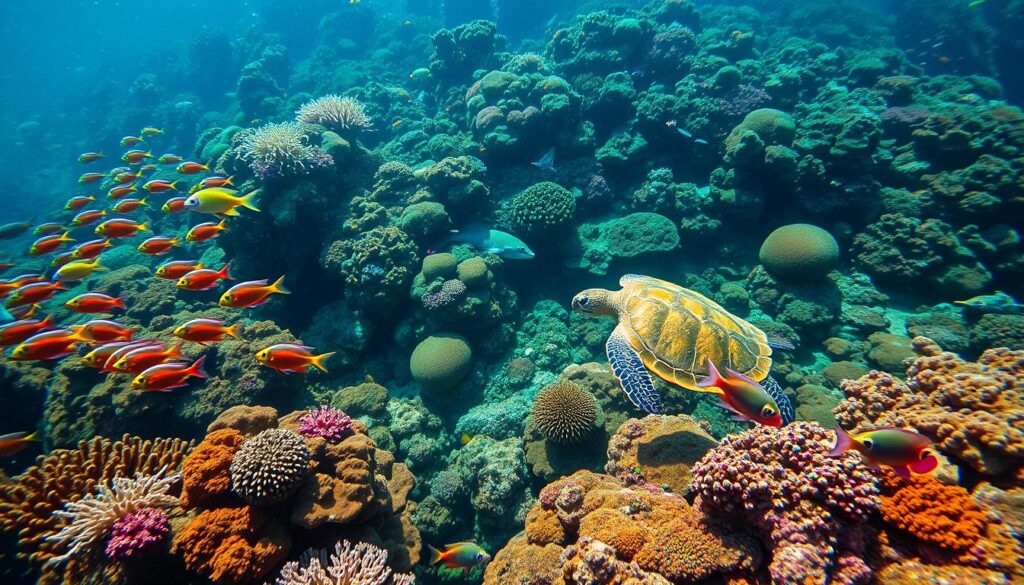
Every dive is a chance to see the amazing variety of marine life. By diving responsibly, we help protect these special places. This way, we can enjoy their beauty and wonder.
Environmental Responsibility in Diving
Scuba diving with Corals diving is more than just fun. It’s a chance to help protect the ocean and its creatures. We can all play a part in keeping the underwater world safe.
The 2022 IPCC report shows coral reefs are in big trouble. They face threats from warmer and more acidic waters. As divers, we must do our best to reduce our impact on these vital ecosystems.
Protecting Coral Reefs
Coral reefs are key to our planet’s health:
- They keep our oceans diverse
- They feed many sea creatures
- They protect us from storms
- They help local economies grow
Sustainable Diving Practices
Here are ways divers can help:
- Stay steady in the water
- Don’t touch or scare marine life
- Use sunscreens that are safe for reefs
- Join in on underwater cleanups
“Every dive is an opportunity to protect our ocean’s most precious ecosystems.” – Marine Conservation Expert
The Coral Triangle is a prime example of how important Marine Protected Areas are. By diving responsibly, we help keep these underwater worlds safe for the future.
Remember: Your actions underwater can protect or harm delicate marine environments. Choose to be a responsible diver.
Enhancing Your Diving Skills
Diving is more than just a fun activity. It’s a journey of learning and discovery. Scuba diving with Corals Diving lets you grow your underwater skills and connect with others who love diving.
Advanced Courses to Elevate Your Dive Certification
For professional divers, getting better is key to a great dive. Dive certification is more than basic training. It opens up to special diving adventures.
- Night Diving Specialty: Learn to dive in the dark
- Deep Diving Course: Dive safely up to 40 meters
- Underwater Photography: Take amazing photos of marine life
- Marine Conservation Diving: Learn how to protect the ocean
Join a Passionate Diving Community
Sharing snorkeling and dive experiences with others makes them more special. Corals Diving builds a community for learning, growing, and protecting the ocean.
| Diving Community Benefits | Skill Improvement Metrics |
|---|---|
| Network with experienced divers | 20-30% improved air consumption |
| Participate in conservation efforts | 40% increased environmental awareness |
| Access to group dive expeditions | Learn to identify 20-30 marine species |
“Diving is not just about exploring the underwater world, but continuously expanding your skills and understanding of marine ecosystems.”
Investing in advanced dive certification and joining the diving community changes your dives. With Corals Diving, your underwater adventures become deep and meaningful.
The Benefits of Scuba Diving
Scuba diving with Corals Diving is more than just an underwater adventure. It’s a life-changing experience that boosts both physical and mental health. It’s perfect for those who love tropical getaways and dive resorts.
Physical Health Advantages
Diving is a full-body workout unlike any other. The water’s resistance helps build muscle strength and flexibility. Millions of people worldwide enjoy the unique fitness benefits of diving:
- Improved cardiovascular fitness
- Enhanced muscle strength
- Low-impact full-body exercise
- Increased lung capacity through controlled breathing
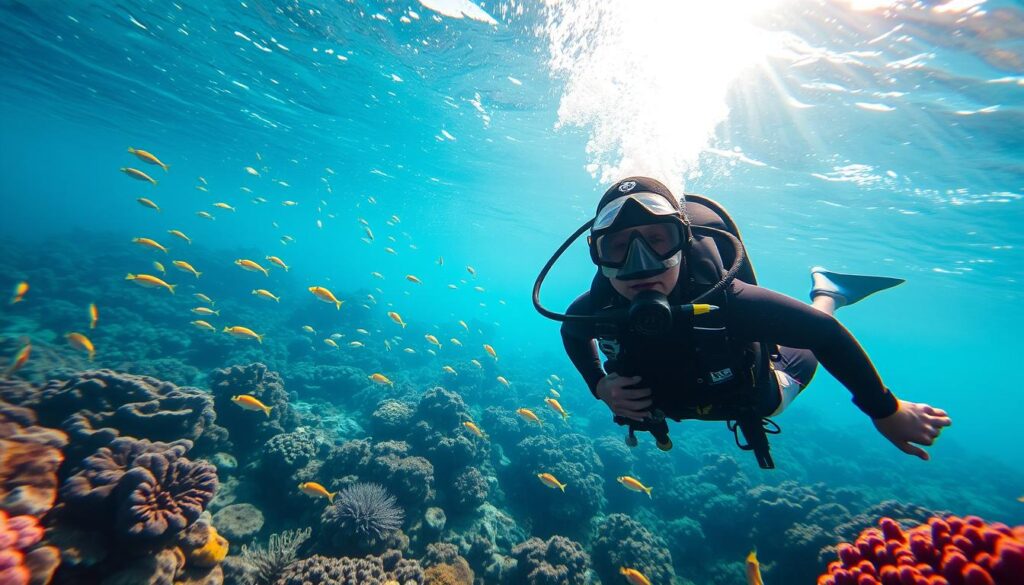
Mental Well-Being Through Diving
Scuba diving is not just a workout. It also offers deep mental health benefits. The underwater world is a calm space that reduces stress and boosts mindfulness.
“The ocean stiils my racing thoughts and connects me to something greater than myself.” – Marine Biologist
Key mental wellness advantages include:
- Stress reduction through calm breathing techniques
- Increased endorphin production
- Enhanced self-confidence
- Social connections within diving communities
Dive resorts and scuba experiences help people grow. They build resilience and a deeper love for marine ecosystems.
FAQs About Scuba Diving with Corals Diving
Scuba diving with Corals Diving opens a world of underwater exploration. Many have questions about their adventure. It’s important to know about dive certification and marine conservation.
Common Questions Answered
New divers often ask about depth limits and training needs. Entry-level scuba diving takes 4-5 days to complete. New divers can dive up to 18-20 meters deep.
Young divers under 12 have depth limits around 12 meters. This is with PADI Open Water Diver certification.
Environmental awareness is key during dives. Divers must control their buoyancy to protect coral reefs. Coral reefs cover less than 1% of the ocean but support 25% of marine species.
Using reef-safe sunscreen and avoiding single-use plastics is important. Minimizing underwater disturbance is also critical for marine conservation.
Resources for Further Learning
Dive enthusiasts can learn more through local groups and online communities. Platforms like TripAdvisor offer insights into dive charters. Professional organizations provide guides for safe diving with Corals Diving.
Continuous learning makes diving safer and more enriching. It benefits both divers and marine ecosystems.
Common Marine Species Found Alongside Coral Reefs
Coral reefs are teeming with an incredible diversity of marine life, making each dive an opportunity to encounter a multitude of fascinating species. From colorful fish to elusive invertebrates, the marine species found alongside coral reefs are as diverse as the reef ecosystems themselves. Here are some of the common marine species you may encounter while diving with coral reefs:
- Clownfish (Family: Pomacentridae): These iconic fish, also known as anemonefish, are recognized for their vibrant colors and the symbiotic relationship they share with sea anemones. Clownfish seek shelter within the protective tentacles of anemones, while providing them with nutrients in return. They are known for their distinctive behavior and can be observed darting in and out of the anemone’s tentacles.
- Parrotfish (Family: Scaridae): Parrotfish are characterized by their bright colors, fused beak-like teeth, and their crucial role in reef ecosystems. They graze on algae, helping to maintain a healthy balance on the reef. Parrotfish also play a vital part in the formation of sand by ingesting coral and excreting it as fine particles.
- Butterflyfish (Family: Chaetodontidae): These graceful fish are known for their vibrant colors and unique patterns. With their thin, disk-shaped bodies, they are perfectly adapted for maneuvering through coral formations. Butterflyfish often form monogamous pairs and can be seen swimming in pairs or small groups, adding beauty and elegance to the reef.
- Moray Eels (Family: Muraenidae): Moray eels, with their elongated bodies and sharp teeth, are a common sight on coral reefs. Despite their intimidating appearance, they are generally non-aggressive and can often be found hiding within crevices or coral heads. These secretive creatures are known for their impressive ability to open their mouths wide to catch prey.
- Sea Turtles (Family: Cheloniidae and Dermochelyidae): Coral reefs serve as important feeding grounds and habitats for various species of sea turtles. Green sea turtles, hawksbill turtles, and loggerhead turtles are commonly encountered in reef environments. These majestic creatures can be observed gracefully swimming among the corals, surfacing for breath, or resting on the sandy bottoms.
- Reef Sharks (Family: Carcharhinidae): Although encountering a reef shark may be a thrilling experience, it’s important to remember that most species of reef sharks are relatively harmless to humans. Common species include the blacktip reef shark, whitetip reef shark, and nurse shark. These graceful predators play a vital role in maintaining the balance of the reef ecosystem.
- Anemones and Anemonefish: Anemones, often found in close proximity to coral reefs, are stunning organisms that provide shelter and protection for a variety of species. Within the anemone’s tentacles, you may spot anemonefish, also known as clownfish, living in a mutually beneficial relationship with their host.
- Manta Rays (Family: Mobulidae): Majestic and captivating, manta rays can be encountered near coral reefs. These gentle giants gracefully glide through the water, feeding on plankton and small fish. Observing their elegant movements is a highlight of any dive.
- Crustaceans: The coral reef environment is home to a diverse range of crustaceans, including shrimp, lobsters, crabs, and mantis shrimps. These fascinating creatures often seek shelter within crevices and coral formations, making them a delight to spot during a dive.
- Invertebrates: Coral reefs are also known for their stunning variety of invertebrates, such as sea stars, sea cucumbers, nudibranchs, and various types of colorful sponges. These organisms contribute to the intricate and vibrant tapestry of reef life.
Encountering these common marine species alongside coral reefs is a testament to the incredible biodiversity and interconnectedness of these ecosystems. Each dive offers a unique opportunity to witness the vibrant colors, behaviors, and adaptations of these fascinating creatures. Remember to observe marine life respectfully, without touching or disturbing them, to ensure the preservation of these delicate ecosystems.
FAQ – Diving with Corals
What equipment do I need for scuba diving?
You’ll need a mask, fins, and a wetsuit or drysuit for a safe dive. Also, a regulator, buoyancy control device (BCD), and dive computer are essential. Corals Diving offers top-notch rentals and can guide you in choosing the right gear.
Do I need prior diving experience to join a Corals Diving tour?
No experience is needed! Corals Diving welcomes all, from beginners to experts. Our certified instructors will train you, making sure you’re comfortable and confident underwater.
What marine life can I expect to see during a dive?
You’ll see colorful corals, tropical fish, sea turtles, and rays. Sometimes, dolphins or whale sharks appear, depending on the location and season.
How safe is scuba diving with Corals Diving?
Safety is our main focus. We follow strict safety standards, use quality equipment, and have experienced instructors. We also provide detailed safety briefings before each dive.
What dive certifications do you offer?
We offer PADI certifications from Open Water Diver to Rescue Diver. You can also take specialty courses like underwater photography and marine conservation diving.
How can I contribute to marine conservation during my dive?
We teach sustainable diving practices on our tours. We aim to minimize environmental impact and support local marine conservation efforts.
What are the physical requirements for scuba diving?
You need to be in good health and able to swim. A basic fitness level is recommended. If you have health concerns, a medical check is advised.
Can I take underwater photos during the dive?
Yes! We offer underwater photography courses. Our tours often include professional photography instruction options.
What locations do Corals Diving operate in?
We dive in incredible locations like the Great Barrier Reef and the Caribbean. We also explore Southeast Asian marine parks and hidden gems with pristine coral.
How can I prepare for my first diving experience?
Start with a swimming course and practice relaxation techniques. Learn breathing exercises and attend our pre-dive training. This will help you feel confident and ready for your first dive.
